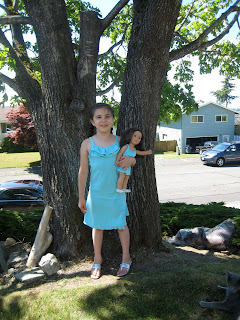So, what is copyright? Princeton's Wordnet defines it as "a document granting exclusive right to publish and sell literary or musical or artistic work." Now, what this means with a pattern is that, if you have it copyrighted, you have legal right to the pattern itself. Only you can sell and publish that copyrighted item. But, with sewing and knitting patterns, what does this mean for the article you create from said pattern? Technically, in the United States, a copyright does not give you control over the articles made from your pattern. Many people who create patterns think that it does and they will even list on their pattern that they do not give you the right to sell anything you create from it. But, they are wrong. And sometimes they will sell licenses for you to make their products, but, according to what I have read, they don't actually have a legal footing on that one, either!
So, how do I know all of this? Well, first of all, there is an interesting website called Tabberone and they have a great deal of information online about all of this. They have a page for copyright definitions. From their page on patterns:
We cannot locate a single federal lawsuit that went
to trial where someone has been sued over the use of a pattern. Consider
the millions of patterns that have been sold
in the last sixity years plus and not one lawsuit? It certainly cannot
be because purchasers are strictly following the demands of the pattern
manufacturers.
Patterns manufacturers do not have the legal right to make many of the
demands that they make. Of the major pattern companies, Simplicity,
Butterick,
McCalls and Vogue, not one has posted on their web sites
anything remotely concerning customer limitations on the use of their
patterns.
Why do you suppose that is? They know they cannot legally restrict the
use but they will tell you differently if you email them. The pattern
companies are in the
business of selling patterns and the great majority of them routinely
lie about the use of those patterns.
Now, doesn't that make sense?
A pattern can be a template, or set of templates, for manufacturing an
item, be it a bird house or a dress. Templates are not copyrightable. A
pattern can also be
drawings accompanied by instructions for knitting, crocheting or
quilting. A method or procedure is not copyrightable. While the drawings
themselves
could possibly qualify for copyright protection, the actual instructions are not copyrightable. The only other aspect of patterns that
could possibly qualify for copyright protection would be the artwork and that would only be if its intrinsic properties allowed it to be
separable from the design, which very, very few designs can do. And to be enforced a copyright almost always must be registered.
Now, that makes even more sense! And, according to Tabborone, pattern makers are lying if they try to tell you that you cannot sell something you make from their pattern.
Now, I know that I, as a home sewist, would be very scared if Amy Butler or Ottobre or some other company sent their lawyers to call on me to tell me to stop selling items made from their patterns. I purposely do not sell items I make from those patterns. But, I do find it annoying that they try to bully people into buying with these lies that you are not supposed to do it! And I wanted to share what I know with you.
A few other items of interest learned from Tabborone:
You can sell anything you want using licensed, character fabric. Once you buy the fabric, it is yours to do with what you please. Tabborone has more information on legal actions about that on their site.
Cottage licenses are total bunk. They are just a way for the pattern maker to make more money. You don't need to buy one. They are not legally required for you to use the pattern in your cottage business.
Knowledge is power! Have a look around the Tabborone website. It is incredible! They have tons of legal citings and definitions. It is a great resource.
Happy Sewing!


















